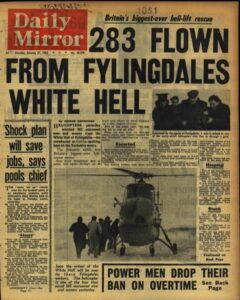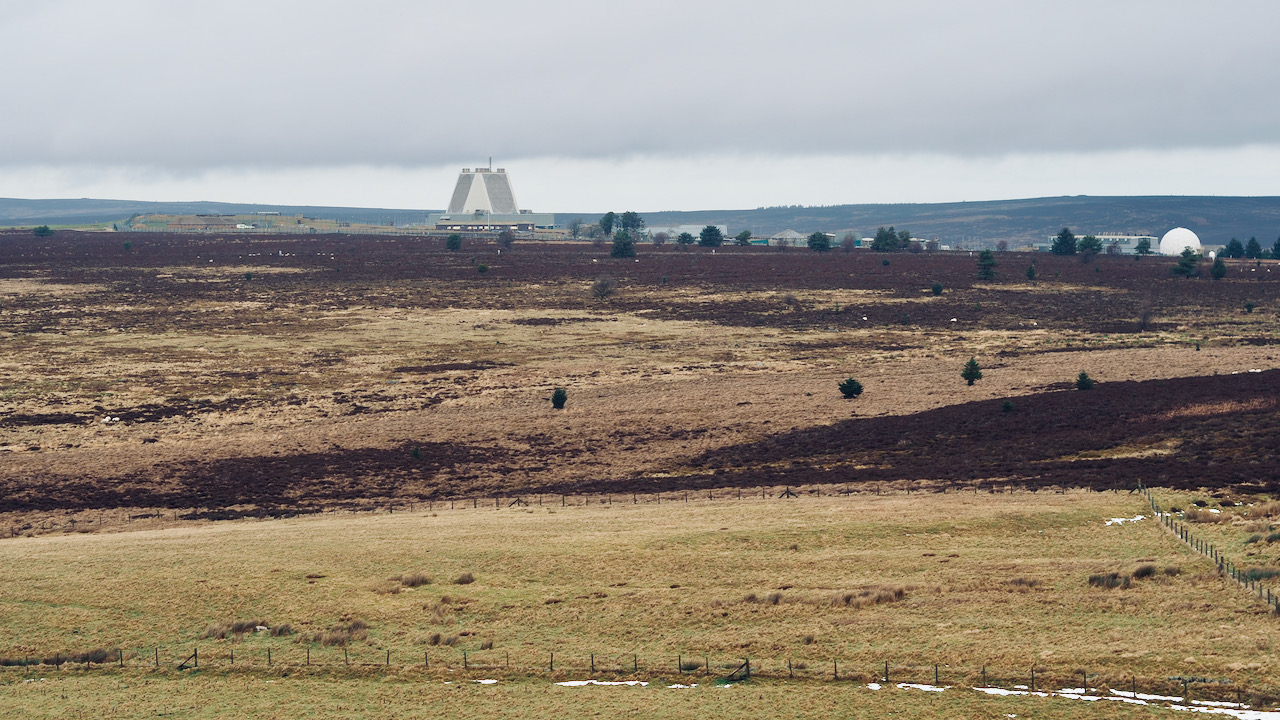As we batten down the hatches in preparation for Storm Isha, the more mature of you might remember the so-called ‘Big Freeze of 1963‘, during the winter of that year. It stood as one of the coldest winters since the notorious one of 1946/7. Temperatures plummeted, leading to the freezing of lakes and rivers. The freezing temperatures persisted, with snow lingering in many areas well into early-April.
I would’ve been 10½ back then, in my last year of junior school. I recall going sledging at the nearby park, a pretty uncommon pastime considering I grew up in a city in the shelter of the Trent valley. It’s quite plausible that this happened during that year.
The North York Moors took a real battering. On this very day in 1963, the Daily Mirror splashed across its front page the headline ‘283 FLOWN FROM FYLINGDALES WHITE HELL’1‘Exhausted by the Agony of Fylingdales, a Man Is Helped to One of the Mercy-Airlift Helicopters That Flew in through a Gale. | Daily Mirror | Monday 21 January 1963 | British Newspaper Archive’. 2024. Britishnewspaperarchive.co.uk <https://www.britishnewspaperarchive.co.uk/viewer/bl/0000560/19630121/006/0001> [accessed 21 January 2024]
 The day earlier, 283 civilians were airlifted by helicopters from the RAF Fylingdales early-warning base, where they had been blocked in by snow for several days.
The day earlier, 283 civilians were airlifted by helicopters from the RAF Fylingdales early-warning base, where they had been blocked in by snow for several days.
The biggest-ever helicopter rescue in British history went down when four RAF Coastal Command Whirlwinds braved an 80 mph gale to airlift the folk out of the snowbound base. These helicopters, stationed in Leconfield, Yorks., and Acklington, Northumberland, shuttled back and forth, facing a relentless tempest that tossed up a 50ft. snowy curtain. Each flight could only rescue eight at a time.
First in line for salvation were the 51 women—clerks and typists—stranded at the £43m early-warning radar station. According to The Mirror, these ladies, escorted by two sturdy gents each to prevent them from turning into aerial tumbleweeds in the ferocious gale. Walking upright was an unattainable feat in those wild conditions.
Their destination: Whitby, a mere eleven miles along the coast. The lucky evacuees soared over 10 ft. drifts that had held them captive since the Wednesday. The audacious airlift commenced at 11 a.m. and wrapped up as darkness fell. A daring rescue, indeed.
The helicopters landed on a golf course, which acted as the command centre for the rescue operation. Subsequently, many were transported via buses to hotels in Whitby, as going home wasn’t an option due to the blockade of three main roads out of town.
Twelve of the stranded workers were taken to hospital, enduring the effects of exposure. They had previously attempted to walk from Fylingdales to Goathland railway station, a distance of four miles. While a few managed to navigate the route successfully, the majority were thwarted by the substantial snowdrifts. On Friday afternoon, seven coaches endeavoured to depart from the base but soon became stuck, necessitating a return journey on foot.
Rest assured, two hundred or so staff stayed on at the remote base, predominantly RAF personnel, maintaining a presence, always watchful in the event the Soviet Union tried to advantage of the country’s predicament.

In 1963, the Fylingdales “golf balls” dominated these moors. These radomes casting a conspicuous presence that extended for miles. They served as a rather vexing landmark for those crossing the Lyke Wake Walk, their distant appearance stubbornly maintaining a semblance of distance.
Recalling the Big Freeze of ’63 stirs memories of the daring rescue at RAF Fylingdales, as helicopter pilots braved gales to airlift the 283 folk trapped there. A tale of the moors. The early-warning base has been here as long as I can remember. Some say the modern truncated pyramid is less of an impact on the moors. But I am not convinced. It still constitutes an intrusive blot on the skyline.
- 1‘Exhausted by the Agony of Fylingdales, a Man Is Helped to One of the Mercy-Airlift Helicopters That Flew in through a Gale. | Daily Mirror | Monday 21 January 1963 | British Newspaper Archive’. 2024. Britishnewspaperarchive.co.uk <https://www.britishnewspaperarchive.co.uk/viewer/bl/0000560/19630121/006/0001> [accessed 21 January 2024]

Leave a Reply